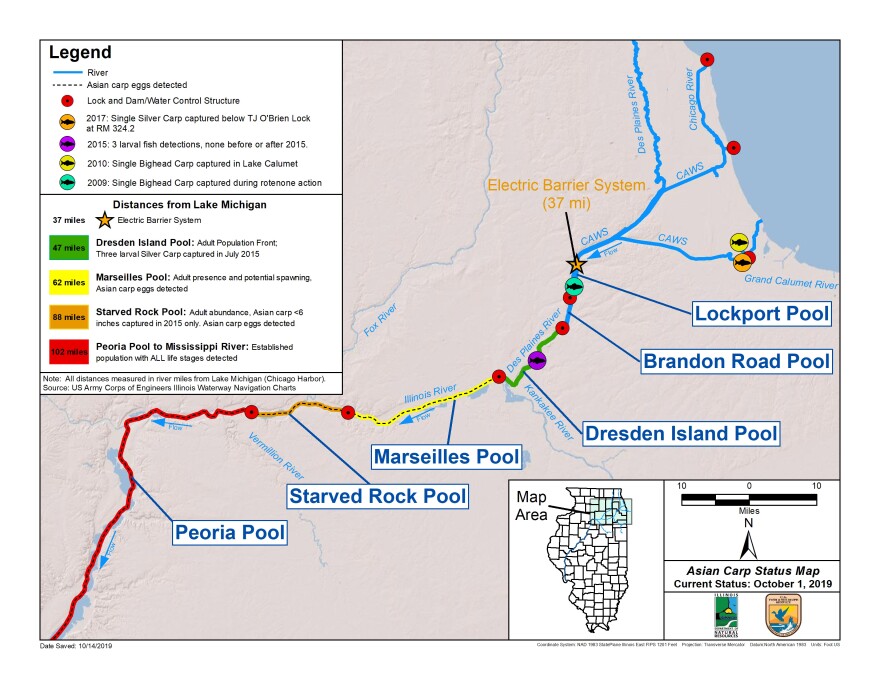People have been talking for years about Asian carp and how the invasive fish might impact the Great Lakes.
In 2002, Asian carp were detected 60 miles from Lake Michigan, in the upper Illinois River. Seven years later, using a new monitoring method called eDNA testing, evidence of the invasive showed up even closer to the Great Lakes basin. That made people worried about its $7 billion fishery and already altered ecosystem even more nervous.

But finding Asian carp DNA in the environment — be it through skin cells or feces — does not mean the dreaded invader is about to slip into Lake Michigan. Amy McGovern, with the U.S. Fish and Wildlife Service, wants to make that point abundantly clear.
"It’s tricky with eDNA because ... there's genetic material everywhere. We've done studies that have shown that eDNA can persist in the gut of a bird for eight days and be able to be picked up through excrement," McGovern tells a group of journalists, just steps from the Chicago River on its watery path to Lake Michigan.
But during a recent routine monitoring in the Chicago River, crews found a record number of Asian carp hits – 73 to be exact. So, they launched two weeks of intensive fishing. While she and her federal and state colleagues don't anticipate finding a live carp, McGovern says they can't be too careful.
"We've got three crews — one from Illinois DNR, one from Fish and Wildlife Service, one from the Corps — electrofishing crews and then two commercial crews with nets. So they’re going to work together to sample that area," she says.
As of the time this story was filed, crews have netted no Asian carp from the Chicago River.

Near Romeoville, Ill., the Army Corps of Engineers manages what has been the primary line of defense to keep Asian carp from pushing into Lake Michigan: a series of electric barriers. They send pulses of power across a section of the Chicago Sanitary and Ship Canal. The first electric barriers went online in 2002.
Charles Shea, Corps project manager, says his team has no reason to believe any carp are challenging the series of barriers.
"We've never captured or sited a carp in the immediate vicinity of these barriers," he explains.

Yet construction of a fourth, even more powerful electric barrier is underway. Shea says Congress authorized the addition in 2007, and says the new barrier will ensure the Corps never loses power in the water. He says one reason some of the advocates wanted the new barrier is for more redundancy.
"Plus, it's gonna have higher power. The new barrier is gonna have two 4.3 megawatt power sources. That gives us the flexibility to potentially getting the smaller sizes of fish," Shea explains.
He anticipates fine tuning the new barrier sometime in 2021.

Meanwhile 10 miles south of Romeoville, fellow Corps member Andy Leichty is overseeing the creation of a multipronged system below the Brandon Road Lock and Dam.
It's still in the "on paper only" phase. But Leichty says it's meant to deter Asian carp and other aquatic invasives by subjecting them to a barrage of electricity, flushing, bubbles, and noise.
"The blue represents the acoustic barrier, the red is the electric barrier and then there's a air bubble curtain at the end of the engineered channel," Leichty says. "That's the current proposed plan, this is in the report that's publicly available."
Leichty estimates it will take eight years to construct and cost approximately $830 million.
Some, including Joel Brammeier who's with the Alliance for the Great Lakes, fear time for effective action is running out, pointing to the recent flurry of eDNA hits in the Chicago River.

"It's another flashing red alarm in a series of alarms that we've had over the last decade telling us that what we're doing isn't enough. That finding, or the next live fish that we catch is not the reason to build Brandon Road. We've already got [the reasons] and it's just another signal that we need to keep moving," Brammeier says.
Thursday the Alliance and 39 other environmental and conservation groups delivered a petition to Illinois Gov. J.B. Pritzker. His signature would signal the U.S. Army Corps of Engineers' move into the Preconstruction, Engineering and Design phase of the Brandon Road project.





